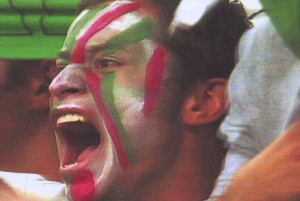This Cup Brimmeth Over
Tribeca has no shortage of places to watch the World Cup. Besides the locations one might expect (Warren 77, Mudville 9, the bars on Murray Street), many high-end restaurants—Macao Trading Co., Blaue Gans, Plein Sud—are bringing out the TVs, and even opening as early as 7 a.m. to show matches live. And then there’s Puma City at the Seaport, with nine flat-screens, an afternoon soccer field, and a weekly dance party (to, er, practice your footwork?).

From "Men With Balls": a still from Miguel Calderón's "México vs Brasil," a 2004 video transferred to DVD (courtesy the artist and Kurimanzutto, Mexico City)
The most intellectual option, however, is Apexart. From June 10 to July 11, the Church Street gallery will host an exhibit called “Men With Balls”: The space is being transformed into “the perfect football environment,” where anyone can come watch the games while surrounded by soccer-related art; there will also be talks and events. From the release: “The World Cup is a spectacle in the strictly Situationist sense. It is a shiny display of nations in symbolic, atavistic national combat adorned with multiple layers of commodification, sponsorship, and the seemingly infinite commercialization. It is an image of our age at its worst and most gaudy. But it is also something more, something bound up with difficult and recalcitrant questions of conflict, memory, history, place, social class, masculinity, violence, national identity, tribe, and group. The hope of the exhibition “Men With Balls” is to construct a unique situation where these questions can be ruminated on collectively.” The opening reception is this Thursday, June 10, from 6 p.m. to 8 p.m.
The shebang—or hebang, I’ll predict—is curated by Simon Critchley. An English philosopher, he’s currently chair of philosophy at the New School for Social Research, and he recently launched a philosophy column in the the New York Times. His most recent book is The Book of Dead Philosophers.
Is there much of an overlap between the worlds of art and football? The working-class-ness* (for lack of a real word?) of the latter seems at odds with the rarifiedness of the former.
The origins of this show come from a passion for football shared with some artists I know, like Philippe Parreno and Liam Gillick. Also, not all art is so rarified and some artists are working-class. Philippe Parreno made the stunning movie, Zidane, together with Douglas Gordon, and this movie alerted me to the links between football and art. I began to play with the possibilities of exploring further the connections between art and football and began to gather the work that will appear in the show. But the center of the show wil be the games themselves. I hope that some sort of group begins to emerge around the games, some sort of situation. If that happens at least once and people have a nice time, I’ll be happy.
Also, I was in New York for the World Cup in 2006 and was struck by the amount of people who were interested in the games. Not everyone wants to go to a sports bar. “Men With Balls” is a wonderful alternative and I’d love Tribeca residents to drop by and view games.
The aim of the show is to create “the perfect football environment.” What does that entail—crisps and beer?
No crisps, but I have carefully curated the beer, which will be sold at cost and any profits donated to the Fresh Air Fund. No one will make a cent out of this show.
Would you describe a few of the artworks in the exhibit? Were they created for the show?
Liam Gillick has covered the walls with white-on-white texts, based on football chants. Roger Bennett has assembled his prodigious collection of football music memorabilia into a vast and rather gaudy display of album covers and a mixtape of music. Other works reflect my origins and personal obsessions, such as audio recordings of Bill Shankly, legendary manager/coach of Liverpool F.C., my team.
On YouTube, I saw a clip of Mark E. Smith announcing match results. [The Fall frontman is listed in the “Men With Balls” materials as a contributor.] Will he be announcing them especially for the show?
No, we’re going to use that footage and run it on a little screen, alongside a film of a boy playing with an invisible ball and the great Charcot playing football naked.
Did you consider referring to the sport as soccer, given Apexart’s location?
Sure. I’m easy about what we call it. Just as long as people experience the grace and beauty of the game!
[* I later realized that this presupposition was flawed. While European soccer fans used to be predominantly working-class, the sport has increasingly been a way to prove you’re salt of the earth—reverse snobbism, if you will. That’s probably more so in the U.S., at least for white Americans. (Do working-class white Americans care about soccer? Surely not the way American immigrants of all economic levels do.) See what happens when you talk to a philosopher about these things?]












